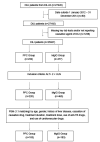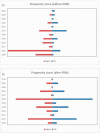Exploring the efficacy and safety of polyene phosphatidylcholine for treatment of drug-induced liver injury using the Roussel Uclaf causality assessment method: a propensity score matching comparison
- PMID: 34433332
- PMCID: PMC8404657
- DOI: 10.1177/03000605211039810
Exploring the efficacy and safety of polyene phosphatidylcholine for treatment of drug-induced liver injury using the Roussel Uclaf causality assessment method: a propensity score matching comparison
Abstract
Objective In China, polyene phosphatidylcholine (PPC) is widely used to treat alanine aminotransferase (ALT) elevation associated with various liver diseases. Here, we assessed the efficacy and safety of PPC in treating drug-induced liver injury (DILI).Methods Data from a multicenter retrospective cohort study (DILI-R) were analyzed to compare PPC and magnesium isoglycyrrhizinate (MgIG) for treatment of DILI. We used the Roussel Uclaf causality assessment method (RUCAM) to evaluate patients with DILI. Patients with RUCAM scores ≥6 were included in the study, while those with RUCAM scores <6 were further evaluated by a panel of hepatologists. The primary outcome was the proportion of patients with ALT normalization at discharge. Propensity score matching was used to identify 183 matched pairs of patients (366 patients in total) from 25,927 patients with DILI.Results Among the DILI patients, 64 of 183 (34.97%) achieved normal ALT levels after treatment in both the PPC and the MgIG groups.Conclusion There were no significant differences in safety biomarkers including serum creatinine, blood urea nitrogen, white blood cells, platelets, hemoglobin, and albumin between patients treated with PPC or MgIG. The safety and efficacy of these two agents for treatment of DILI were comparable.
Keywords: Drug-induced liver injury; Roussel Uclaf causality assessment method; alanine aminotransferase; magnesium isoglycyrrhizinate; polyene phosphatidylcholine; propensity score matching.
Conflict of interest statement
Figures


Similar articles
-
An analysis of silybin meglumine tablets in the treatment of drug-induced liver injury as assessed for causality with the updated Roussel Uclaf Causality Assessment Method using a nationwide database.Br J Clin Pharmacol. 2023 Apr;89(4):1329-1337. doi: 10.1111/bcp.15575. Epub 2022 Nov 10. Br J Clin Pharmacol. 2023. PMID: 36278948
-
Advances in Idiosyncratic Drug-Induced Liver Injury Issues: New Clinical and Mechanistic Analysis Due to Roussel Uclaf Causality Assessment Method Use.Int J Mol Sci. 2023 Jun 29;24(13):10855. doi: 10.3390/ijms241310855. Int J Mol Sci. 2023. PMID: 37446036 Free PMC article. Review.
-
Idiosyncratic Drug-Induced Liver Injury (DILI) and Herb-Induced Liver Injury (HILI): Diagnostic Algorithm Based on the Quantitative Roussel Uclaf Causality Assessment Method (RUCAM).Diagnostics (Basel). 2021 Mar 6;11(3):458. doi: 10.3390/diagnostics11030458. Diagnostics (Basel). 2021. PMID: 33800917 Free PMC article. Review.
-
Drug Induced Liver Injury: Can Biomarkers Assist RUCAM in Causality Assessment?Int J Mol Sci. 2017 Apr 11;18(4):803. doi: 10.3390/ijms18040803. Int J Mol Sci. 2017. PMID: 28398242 Free PMC article. Review.
-
Top-ranking drugs out of 3312 drug-induced liver injury cases evaluated by the Roussel Uclaf Causality Assessment Method.Expert Opin Drug Metab Toxicol. 2018 Nov;14(11):1169-1187. doi: 10.1080/17425255.2018.1539077. Epub 2018 Oct 29. Expert Opin Drug Metab Toxicol. 2018. PMID: 30354694 Review.
Cited by
-
Chinese guideline for the diagnosis and treatment of drug-induced liver injury: an update.Hepatol Int. 2024 Apr;18(2):384-419. doi: 10.1007/s12072-023-10633-7. Epub 2024 Feb 24. Hepatol Int. 2024. PMID: 38402364
-
Effectiveness and Economic Evaluation of Polyene Phosphatidyl Choline in Patients With Liver Diseases Based on Real-World Research.Front Pharmacol. 2022 Mar 7;13:806787. doi: 10.3389/fphar.2022.806787. eCollection 2022. Front Pharmacol. 2022. PMID: 35330831 Free PMC article.
-
Treatment of Drug-Induced Liver Injury.Biomedicines. 2022 Dec 21;11(1):15. doi: 10.3390/biomedicines11010015. Biomedicines. 2022. PMID: 36672522 Free PMC article. Review.
-
Therapeutic Management of Idiosyncratic Drug-Induced Liver Injury and Acetaminophen Hepatotoxicity in the Paediatric Population: A Systematic Review.Drug Saf. 2022 Nov;45(11):1329-1348. doi: 10.1007/s40264-022-01224-w. Epub 2022 Aug 25. Drug Saf. 2022. PMID: 36006605 Free PMC article.
-
Targeting chronic liver diseases: Molecular markers, drug delivery strategies and future perspectives.Int J Pharm. 2024 Jul 20;660:124381. doi: 10.1016/j.ijpharm.2024.124381. Epub 2024 Jun 23. Int J Pharm. 2024. PMID: 38917958 Free PMC article. Review.
References
-
- Fan XF, Deng YQ, Ye L, et al.Effect of Xuezhikang capsule on serum tumor necrosis factor-alpha and interleukin-6 in patients with nonalcoholic fatty liver disease and hyperlipidemia. Chin J Integr Med. 2010; 16:119–123. - PubMed
-
- Li L, Zhang XJ, Lan Y, et al.Treatment of non-alcoholic fatty liver disease by Qianggan capsule. Chin J Integr Med. 2010; 16:23–27. - PubMed
Publication types
MeSH terms
Substances
LinkOut - more resources
Full Text Sources
Medical

